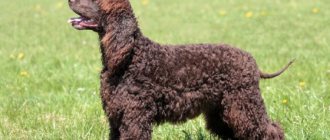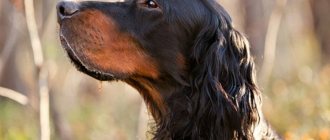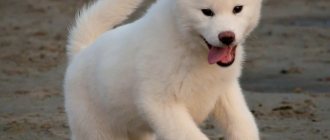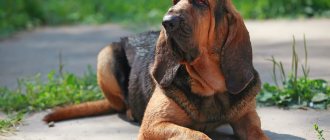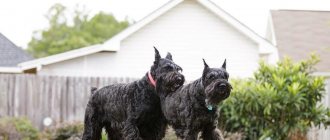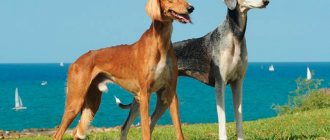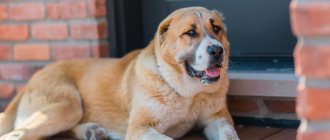- Pets
- >>
- Dog breeds
* Here is a photo of a typical representative of the Irish Setter dog breed . You can send us photos of your animals by email, and we will post them on the website. Don't forget to send your pet's name.
Other breed names:
Irish Red Setter
Video
* We invite you to watch a video about the Irish Setter . In fact, in front of you is a playlist in which you can select and watch any of 20 videos about a given dog breed by simply clicking on the button in the upper right corner of the window. In addition, the material contains quite a lot of photos. By looking at them you can find out what an Irish Setter looks like.
In this article:
|
Rate the material!
[Total votes: 3 Average: 5]
In the variety of dog breeds, there are sure to be everyone’s favorites, whose attractive appearance, coupled with their extraordinary intelligence and friendly character, invariably win the hearts of people around the world. This is exactly what a handsome European with a luxurious red-chestnut coat is like - the Irish Setter .
History of the Origin of Irish Setters
The first written mentions of the Irish Setter breed were made a long time ago, back in the middle of the 15th century. In those sources, the term “setter” did not designate a specific type of dog, but united under its name groups of animals related to hunting wild birds.
To date, it has not been possible to reliably determine which dog species can be attributed to the ancestors of the modern Irish Setter. The scattered information that has reached us indicates that Blandhounds, spaniels, pointers and even wolfhounds participated in the formation of the breed’s genotype.
According to stud books, deliberate breeding of setters began in the second half of the 18th century. However, almost a century passed before the breed was officially identified as a separate type. Over the next couple of decades, several clubs for Irish Setter lovers were registered and a breed standard was approved.
When breeding activity regarding the Irish Setter was just gaining momentum, there were cases of mating of hunting and exhibition varieties. These experiments led to the fact that the puppies began to degenerate their breed traits. Concerned about the state of affairs, breeders stopped such matings.
Interesting fact: It is known that Americans preferred show varieties of setters, cultivating the qualities of a show breed. Therefore, American-made Irish Setters are somewhat different in appearance from their European counterparts.
And Russian breeders have always relied on breeding hunting lines. Moreover, breeding work was carried out very actively. Even before the revolution, there were many elite-level nurseries in the country, which had the highest patronage of princely families. The breed was constantly improved due to purebred sires imported to Russia from Europe.
But since no special attention was paid to show qualities, the domestic population of setters did not take part in international exhibitions.
What are the differences between the Gordon Setter?
It is important to note that the main popularity that the Gordon Setter dog gained in America dates back to 1842; photos of this animal are still presented in many magazines and books that are dedicated to hunting and published in this country. It was in that year that US breeders were able to improve the type of this dog. They bred them with imported Gordons and thus developed a special breed. As a result, the animal acquired additional characteristics, the dogs received excellent working qualities and an even more aesthetic appearance. And, of course, as a result, their popularity among hunters increased significantly.
It is worth noting that dog lovers did not allocate working or exhibition specimens for participation in various exhibitions and competitions. Therefore, we can say with confidence that the bred breed was impeccable and universal.
If we talk about the modern Gordon Setter, then it certainly has excellent performance characteristics. Although in appearance it still resembles an English or Scottish Setter. It is also worth noting that in numerous tests, individuals of small structure show themselves at their best. But exhibitions, on the contrary, are mostly won by large specimens of this breed.
Irish Setter - description of the breed
This intellectual is always friendly and very approachable. He trusts the world around him and all living beings - be it his fellow tribesman, a person or even a cat. The Irish Setter is active most of the day, sometimes it seems that he does not know what fatigue is at all, and his energy would be enough for two.
Of course, the setter is a hunter, first and foremost. However, aggression, deadly grip, malice and an unbridled desire to dominate are not at all among his priorities. He is an intellectual and a “gentleman” with excellent hunting skills and instincts. His stature, proud posture, high, fast legs have always been a constant and beautiful attribute of elite hunting.
The breed standard determines the height at the withers:
- For males – 58-67 cm;
- For bitches – 55-62 cm.
The coat of setters is smooth and silky, of medium length. On the stomach it forms a so-called “fringe”, which is more pronounced in show animals. They can boast of the special satin shimmer of their red-chestnut hair. Working setters look much more modest. However, a coat that is too long and curly is considered a disqualifying feature for the breed.
Interesting fact: The classic coat color, according to the breed standard, is chestnut. Small white spots on the neck, chest and forehead are considered acceptable. Blacks - no.
The Irish Red Setter owes its special feature to its well-proportioned body and long, muscular limbs. The dog is especially beautiful in motion. Moves at a classic gallop, while holding its head high. The powerful hind legs give a springy push, and the front legs give a high, beautiful reach.
Another characteristic feature of the breed is the ears. They are set low on the setter, hanging along the muzzle, framed by silky hair and very soft to the touch. If the setter's ears curl into a tube or droop in a burdock-like manner, this is considered a disqualifying sign.
The setter's tail is straight or saber-shaped. The base of the tail is massive, tapering towards the tip. Females have a tail 2-3 cm longer than that of males. If the tail is too short or too curved, the breeding commission recognizes it as a defect.
Breed standard
The Irish Setter is a large dog. But it is worth noting that, compared to other large species, the setter does not have overly developed muscles.
Based on their appearance and build, Irish Setters are divided into two varieties:
1. Field dogs are a working group of hunting dogs. Its representatives had a lighter build and shorter coat. This is explained by the fact that when chasing and catching game, the setter needs speed; long hair and heavy weight only interfere with the hunt. 2. Show dogs are show-class dogs; they are considered more of an ornamental species than a hunting dog. The physique is heavier and larger. The coat is thick, luxurious and long. The decorative hair is wavy.
The standard for the Irish Setter breed has been established. According to it, the height of adult individuals is 55-67 cm , weight is about 27-32 kg.
The neck is of medium length, strong, with a beautiful bend. A narrow, rather long head rests on it. The occipital protuberance is pronounced. The forehead is voluminous and oval in shape. Length equal to the length of the muzzle. The ears are hanging, set low with decorative hair.
Medium-sized, almond-shaped eyes. The eyelids are not droopy. Color ranges from nutty to rich brown. The look almost always expresses friendliness, joy and curiosity.
The jaws are strong. The nose is not too large with large nostrils. Lips are of medium thickness, not droopy. Medium sized teeth. Scissor bite.
Elongated physique. The stomach is tucked. The hemline is a nice curve. The back is straight. The chest is of medium width, reaching down to the elbows.
Tail with beautiful decorating hair. It is wide at the base and gradually narrows towards the end. The Irish Setter holds it at back level or slightly higher, not vertically.
The legs are moderately muscular, smooth, strong, and quite long. The paws are not large, round in shape.
The coat is of medium length, smooth, straight, with slight waviness allowed. There is slight undercoat. The fur on different parts of the body is not the same:
- The head, muzzle, and front of the paws are short.
- Body – medium length, thick.
- Ears, paws, underline, tail - smooth, long feathers.
Color ranges from deep mahogany to chestnut to light red. White markings are allowed on the chest, toes and muzzle.
Popular colors of Irish setters
The ancestors of the Irish Setters were red or white and red in color. They were even called “red spaniels.” But Irish breeders made every effort to achieve the unique red-chestnut shade of the breed’s coat. Now this particular color is considered the most popular and is appreciated by Irish Setter lovers all over the world.
The intensity of the color is determined by the quality of the coat, its structure, density and thickness of the hair. For example, the hair on a setter's legs, ears and tail is finer than the hair on the body, so they tend to be less intensely colored. In general, the coat color of classic Irish setters has several shades - from red to red and red-chestnut.
The color of the Irish Setter is significantly influenced by the orientation of the breed. As you know, show varieties have a brighter coat color; they deserve the title “Red Irish Setter”. But working setters cannot boast of such a dazzling coat and color intensity.
The breed standard allows white spotting in dogs if the markings are located on the chest, neck or on the tips of the paws. If the spotting is more pronounced, you have a representative of a special breed - the Irish Red and White Setter.
Character and habits of Irish setters
The hunting orientation of the breed leaves an imprint on the character and habits of the Irish Setter. Dogs are passionate and active, easy-going, fairly well controlled, but cannot boast of much endurance. When a setter hunts, he mainly relies on his senses, which he has well developed, and uses hearing and vision minimally.
The increased temperament of an animal prevents it from concentrating for a long time on any one object or type of activity. This feature makes it difficult to train setters. Their training is not an easy process, requiring the owner to have sufficient patience and a clear plan for training with the pet.
Already from 3.5 months, puppies are quite capable of assessing the situation around them for hierarchy, so it is important not to miss the moment and establish the status quo in time, which will simplify communication between the owner and the pet in the future. From this age you can start training your dog and teaching basic commands.
Interesting fact: Irish Setters are self-sufficient and stubborn. Therefore, you should not expect unquestioning and precise execution of commands from them, as, for example, from shepherd dogs. They are less efficient, although obedient, and often improvise when executing commands. This should be taken into account so as not to overdo it in training and not completely discourage your pet from training.
Communication with an Irish Setter is a difficult but exciting process. The owner and the pet simultaneously study each other’s habits, and the setter tries not to be inferior to the person in cunning and resourcefulness. If he does not want to follow commands, he demonstrates misunderstanding with such genuine regret that an inexperienced dog breeder can follow the cunning lead and cancel the lesson. But if the setter is caught in cunning, you should not force him to submit by force, it is better to show your disappointment at his reluctance to work. Remorse will not allow the pet to continue the “circus”, and he will return to classes.
You shouldn’t overuse such tricks; the owner of an Irish Setter has to be on guard and not fall for the tricks of a savvy pet. If it is possible to find a balance of relations in this matter, then the threat of raising an obstinate lazy person will be minimized.
In general, the Irish Setter is very efficient. He gets along well with children and can play with them for a long time without showing aggression even in response to unceremonious treatment. Loves long walks in the fresh air and active games. They just perfectly reduce the pet’s craving for adventure. Having walked and run until he drops, the setter, returning home, will most likely prefer to rest somewhere in a secluded corner. If his excess energy is not given an outlet, he will have to look for entertainment on his own, and he will no doubt find it.
You should not try to make the Irish Setter a home watchman or security guard. His innate friendliness, simple-minded disposition and lack of aggression make him more likely to be friendly with strangers than defensive.
Character
Aggression, excessive anger, and dominance are not inherent in the Irish Setter. The main traits of his character are friendliness, devotion, energy, playfulness, and mischief. It is also worth noting the setter’s high intelligence, mental abilities, and adequacy.
The setter does not like to lie down and rest for hours. He prefers active recreation, walks, and outdoor games. He will be very happy to accompany his owner on morning jogs or run next to the bicycle.
The Irishman is very efficient. He is ready to follow the commands of even a small child, especially if this is followed by tasty reward. In general, the setter gets along with children. For them, he can become a wonderful nanny and playmate. It is not recommended to leave such an energetic and large dog alone with very young children. She may unintentionally harm the baby during the game.
Pay attention to our article: TOP 30 best dog breeds for children
Does not conflict with pets. He can be friends and eat from the same bowl even with cats. Strive to have a companionable relationship with dogs. The setter is not pugnacious; it is preferable for him to invite a fellow dog to play or run a race than to start a fight.
A guard and watchman is not about the Irish Setter. A friendly dog is not capable of showing aggression towards people. He would rather greet a stranger than bark at him.
Interesting facts about Irish setters
The Irish Setter is an amazing and interesting breed. Dog lovers all over the world value it not only for its professional hunting qualities, friendly character and high intelligence, but also for its exceptional external characteristics, which, in turn, are actively used for commercial purposes by marketers and advertisers.
Thanks to its attractive appearance, the Irish Setter has become a media personality. His image often appears on our television screens and on the Internet. Commercials featuring setters have very high ratings, regardless of the product category the advertisement belongs to. And even the Irish bus company chose the image of the Irish Setter as its logo.
It is known that during his visit to Ireland, US President John Kennedy was presented with an Irish Setter puppy, which later became his favorite. At one time, A.S.’s father also chose an Irish red setter as a pet. Pushkin - Sergei Lvovich.
Speaking about interesting facts regarding this breed, it is worth noting that the metabolism in the body of the Irish Setter is much faster than that of other breeds. Therefore, the setter usually eats more food than any other dog of a similar size and size.
Rehabilitation centers in many countries use the Irish Setter, which makes excellent companions, to work in nursing homes, hospices and as home therapy dogs for people with disabilities.
Pros and cons of Irish Setters
At first glance, the good-natured, handsome Irish Setter will suit almost any owner. But this is a superficial judgment. In fact, the owner of such a dog should be a person who can find the right approach to raising a pet and will have enough time to communicate with it. Before you decide to buy a puppy, you need to weigh the pros and cons.
The breed has undeniable advantages:
- Setters are friendly, non-aggressive and sociable. It is difficult to find a kinder breed. They are always ready for dialogue with the owner and are endlessly devoted to him;
- The active and playful nature of the setter allows him to become an excellent “nanny” for the owner’s children and an excellent playmate;
- Having other pets in the house does not create problems for the Irish Setter. He gets along quite well with other living creatures in the same territory and sometimes even shows a kind of guardianship over the others, feeling increased responsibility from the position of an older and stronger comrade;
- The Irish Setter is an excellent hunter. His main passion is birds and swamp game. And if this interest coincides with the owner’s, then a strong partnership tandem is formed, giving pleasure to both and strengthening the connection between a person and his pet;
- Possessing extraordinary intelligence, the Irish Setter is capable of self-learning and perfectly adapts to any life circumstances;
- Care and maintenance of the Irish Setter at home are practically no different from other dog breeds. If you don’t pamper him unnecessarily, he is quite unpretentious in everyday life and food.
However, there are some disadvantages that you should pay special attention to:
- The luxurious hair of a setter requires constant careful care, especially for show-class dogs, but the coat of working setters also needs to be looked after, otherwise it will become matted and overgrown with tangles that will have to be cut;
- Trainability is not the strong point of the Irish Setter. Due to his playful nature and irrepressible energy, it is difficult for him to concentrate on monotonous and boring lessons;
- It is necessary to understand that the natural temperament of the setter does not allow him to sit still for a long time. He needs long walks, active games and physical activity. If the owner cannot provide the animal with these conditions, then it is better not to consider the Irish Setter as a potential pet.
Education and training
Training a pet most often ends in success, but due to its active nature it becomes difficult, because setters are simply not able to sit in one place. For successful training, it is best to create a special program that will not cause rejection in the animal.
It is necessary to start training at the age of 3.5-8 months, since at this time the dog already understands the hierarchy of the family. You should especially teach your dog the commands “Here you go” and “Come to me,” since he is prone to running away.
Important! In order for the Irishman to make contact better, he should be praised after a successfully executed command.
It is strictly prohibited to use physical force on an animal during training.
Breeding Irish Setters
Breeding work regarding Irish Setters is very active due to the great demand for these dogs. But in order to obtain high-quality offspring and prevent the degeneration of the setter’s breed traits, certain conditions must be met.
A bitch is formally considered ready to reproduce if she has reached the age of 15 months. But ideally, a dog should be allowed to breed after the third heat, and in some setters the first heat occurs at the age of two years. This fact must certainly be taken into account. Earlier pregnancies can cause irreparable harm not only to her health, but also to the health of future puppies.
Important fact: Setter males entering the breeding phase must be superior to most of their relatives in all characteristics, which must certainly be confirmed by certificates from competitions and exhibitions. They are allowed to breed at the age of two to four years.
If we talk about the exhibition category of the Irish Setter, then we can distinguish two types of show dogs with the best characteristics - these are the “Irish” with American and English registration. The British succeeded in shaping the classic form of the breed in all its manifestations. American breeders were somewhat overzealous in cultivating the show qualities of the setter, and now the overseas representative of the breed has an appearance that is somewhat different from the traditional one.
The process of breeding Irish Setters is not without disappointments associated with the appearance of various deviations from the standard in puppies.
For example, disqualifying characteristics of the breed are:
- Wide or short head shape;
- Burdock-shaped drooping ears;
- The coat is too long and too curly;
- Slouch, back with a hump;
- Crescent shape and insufficient tail length;
- Lack of pigmentation on the lips, eyelids or nose.
Currently, the majority of owners of Irish Setters have nothing to do with hunting and get such a dog exclusively as a companion. However, many breeders are happy to pay attention to the exhibition career of their pet.
Owner reviews
Setter owners agree that their incredibly beautiful pupils require intensive training. Without it, a freedom-loving dog loses its bearings and is ready to run away from you, smelling the light aroma of game.
It takes a lot of time to learn the “come to me” command, and other commands are not learned as quickly as we would like . The education process is facilitated by close, friendly contact with the owner, which should be established from puppyhood.
Once mutual understanding is established, the dog will obey the owner at a glance and do everything to make him happy. One of the main advantages of the Irish Setter is his absolute goodness and friendly attitude towards strangers.
Sources:
https://simple-fauna.ru/pets/dogs/breed-of-dog/irlandskij-setter/
https://dogipedia.ru/irlandskij-setter/
https://lapkins.ru/dog/irlandskiy-setter/
Caring for Irish Setters
The main expenditure of effort when keeping an Irish Setter, of course, is caring for the pet's coat. Achieving the famous shine and shimmer is not so easy. This is especially true for show dogs, whose hair is much longer than that of hunting varieties. Although it is long in all setters, especially on the stomach. Such wool invariably catches burrs, thorns and dry grass on walks and constantly gets dirty. She also falls down and gets tangled in tangles.
Therefore, you need to be prepared to thoroughly comb your pet’s luxurious hair every day. Natural bristle brushes are usually used for this procedure. The more thorough the daily brushing process, the more pride your pet will take at shows. Particularly enthusiastic breeders use various oils and masks to care for their handsome coat, helping to eliminate dryness and fragility of individual hairs, restore shine and achieve the ideal length.
The process of bathing an Irish Setter, in addition to its hygienic function, is also a kind of beauty procedure, for which special detergents are used to moisturize the skin, as well as various conditioning compounds for a healthy shine and smoothness of the coat. By the way, you need to comb your setter immediately before bathing, because tangled, wet fur will be much more difficult to tidy.
Interesting fact: To save yourself from some of the problems of caring for the coat, it is advisable to walk your pet in dirty and wet weather in a special protective overalls.
The rest of the care for the Irish Setter can be called standard, suitable for most breeds. This includes regular haircuts, trimming the hair on the paws between the toes, trimming nails, daily examination of the teeth, ears and eyes, and cleaning them with special products and solutions, if necessary.
The drop ears of the setter require a little more attention. Due to their structural features, they are poorly ventilated and require additional forced “ventilation” to avoid unnecessary infections and the appearance of parasites.
Maintenance, care and nutrition
When keeping an animal, you must follow a number of rules, violation of which will negatively affect the health of the pet. The setter should live exclusively in a heated room or apartment. The lack of undercoat does not allow the dog to be placed outside, since in cold weather this will cause him hypothermia and colds of varying severity. The dog should be brushed daily using a brush with natural bristles.
Bathing is carried out as needed. You need to use a special shampoo that is designed specifically for dogs. The Setter does not require a haircut. The exception is the hair between the toes, which is often removed to prevent matting.
Ears and eyes are wiped several times a week using cotton swabs. For the eyes, they are soaked in an aqueous infusion of chamomile, and for the ears, they are soaked in an antiseptic such as hydrogen peroxide or chlorhexidine.
Nails are trimmed as needed. Since the dog prefers to walk and run on the ground, its nails are usually not worn down enough and require trimming once a month.
Feed the dog 2 times a day. Preference should be given to natural nutrition. The animal should receive 550 g of meat or fish and 300 g of porridge (buckwheat, rice or oatmeal) per day. It is useful to give your dog by-products. There should always be clean and fresh water in the drinking bowl.
Irish Setter Diet
When feeding an Irish Setter, it is necessary to take into account that the animal has quite long legs, and it will be uncomfortable for him, and it is simply harmful, to bend over to the bowl during each meal or for a portion of water. Therefore, setters need a special stand for the bowl, which will most likely have to be changed a couple of times as the pet grows.
The Irish Setter's diet should be tailored to its physical activity. If a dog goes hunting or has other increased physical activity, then its food should be higher in calories and denser than that of an ordinary couch potato.
Setters are generally quite indifferent to food, use it only to maintain strength and very rarely overeat. At the same time, the main task of the owner is to balance the pet’s menu so that the food is nutritious and contains all the necessary vitamins and microelements. If you use industrial feed, this is easier to do - just choose premium feed with a fat content of 16% or higher.
If preference is given to natural food, then this is, as a rule, red meat, substandard meat and offal in combination with oatmeal or buckwheat.
The natural diet of the Irish Setter can and should be supplemented with the following healthy complementary foods:
- Bone broth;
- Chicken eggs (no more than two pieces);
- Fish fillet (preferably sea fish);
- Seasonal vegetables and fruits;
- Fermented milk products (no whole milk);
- Vegetables are small (about a teaspoon per dose).
In addition, a dog on a natural diet should receive vitamin supplements, the choice of which is best left to a veterinarian.
As with all pets, the following should be absolutely prohibited for the Irish Setter:
- Food from the master's table;
- Any sweets and baked goods;
- Exotic vegetables and fruits;
- Fish and chicken bones;
- Fried, salty and too fatty foods;
- Raw onions and garlic.
How to choose a puppy
When choosing an Irish Setter, it is important to take into account that females have a more docile character than males, but the latter have a more expressive texture. If you need a working dog, then it is better to choose one from a hunting club, where English Setter puppies are presented in huge numbers.
When starting to choose, you need to pay attention to the appearance of the puppy. He should look healthy, with no signs of skin rashes or parasites.
Important! If you need a puppy with a pedigree, you need to buy an Irish Setter from the Ministry of Education and Science.
You should choose a puppy exclusively from nurseries
Diseases and health problems
If the owner cares about the health and well-being of his pet, then the Irish Setter will live at least 12-15 years. And in general, the health of the breed depends on the responsibility of the nursery owner.
If the breeder takes breeding seriously, carries out genetic testing of the litter, carefully selects candidates for mating and does not allow inbreeding, then even hereditary diseases inherent in the genetic code may not appear in the animals.
If the owner is not too concerned about such troubles, then his pets may well have serious health problems.
Namely:
- Otitis. The disease is associated with the structural features of the setter's ears, which, with insufficient care and hygiene, are susceptible to infections and inflammation;
- Dermatitis. Most often it is of an allergic nature and is caused by diet or nutritional disorders;
- Hypothyroidism. Disruption of the thyroid gland can be triggered by an inactive lifestyle with an increased fat diet of the pet;
- Epilepsy. A congenital disease that cannot be treated, but with the right approach can be brought under control.
- Osteosarcoma. Swelling of the animal's motor joints causes significant lameness and is often visually noticeable. In some cases, it can be eliminated surgically or controlled with appropriate medications. Here you cannot do without serious veterinary support;
- Idiopathic megaesophagus. This is a hereditary form of the disease, which is an enlargement of the esophagus. The problem can be corrected with surgery.
- Pyometra. Purulent inflammation of the uterus in bitches. Occurs in dogs that have given birth, more often in those who have experienced an excessively multiple pregnancy;
- Pathologies of the spinal cord. Congenital form.
Of course, it is difficult to deal with hereditary diseases, but if you do timely preventive examinations at the veterinarian, carry out mandatory vaccinations and deworming, and carefully monitor your pet’s well-being, you can avoid most of the setter’s health problems.
